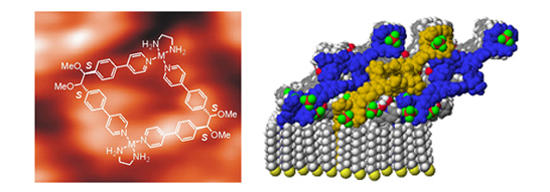Monolayers and Programmed Multilayers of Macrocycles and Rotaxanes on Surfaces
STM Studies of Macrocycles Monolayers
Scanning Tunneling Microscopy performed by Peter Broekmann in Bonn revealed interesting patterns of (chiral) metallo-supramolecular macrocycles which assemble in ordered domains on copper surfaces. Similarly, tetralactam macrocycles can be used to pattern surfaces. In STM experiments by Moritz Sokolowski (Bonn), they exhibit different arrangements among which a chiral one forms on the surface, although the macrocycles themselves are achiral.
Programmed Multilayers of Macrocycles and Rotaxanes
Together with Wolfgang Unger (Berlin), multilayers of macrocycles and rotaxanes have been prepared. An underlying self-assembled monolayer is functionalized with pyridines and terpyridines. In a layer-by-layer self-assembly approach, multilayers of metal ions and tetralactam macrocycles and/or (switchable) rotaxanes can be deposited with precisely defined sequence. Films with more than 20 macrocycle layers and an overall thickness in the order of 40-50 nm have been prepared which exhibit pseudorotaxane formation with squaraine axles.
Besides the coordination chemistry approach to deposit multilayers, azide-functionalized SAMs have been studied in order to attach the subsequent layer covalently by click chemistry.

Left: STM image of a chiral, metallo-supramolecular rhomboid on copper. Right: model of a self-assembled monolayer of tetralactam macrocycles coordinated to an underlying template SAM through iron ion binding
Related Publications
STM Experiments with Metallosupramolecular Macrocycles
- 86
Synthesis of Chiral Self-Assembling Rhombs and Their Characterization in Solution, in the Gas Phase, and at the Liquid-Solid Interface
K. S. Jeong, S. Y. Kim, U.-S. Shin, M. Kogej, N. T. M. Hai, P. Broekmann, N. Jeong, B. Kirchner, M. Reiher, C. A. Schalley
J. Am. Chem. Soc. 2005, 127, 17672-17685
- 85
Formation of 2D supramolecular architectures at electrochemical solid/liquid interfaces
C. Safarowsky, A. Rang, C. A. Schalley, K. Wandelt, P. Broekmann
Electrochim. Acta 2005, 50, 4257-4268
- 59
Second-Order Templation: Ordered Deposition of Supramolecular Squares on Chloride-Covered Cu(100) Surface
C. Safarowsky, L. Merz, A. Rang, P. Broekmann, B. A. Herrmann, C.A. Schalley
Angew. Chem. 2004, 116, 1311-1314; Angew. Chem. Int. Ed. 2004, 43, 1291-1294
STM Studies on Tetralactam Macrocycles
- 129
Molecular Recognition between the Constituents of a Pseudorotaxane studied by Scanning Tunneling Microscopy
M. Sokolowski, I. Kossev, W. Reckien, T. Felder, M.R. Kishan, C.A. Schalley
J. Phys. Chem. C 2009, 113, 12870-12877
- 123
Formation of Chiral Aggregates of Tetralactam Macrocycles on the Au(111) Surface
I. Kossev, T. Felder, C.A. Schalley, F. Vögtle, M. Sokolowski
Springer Proc. Phys. 2009, 127, 235-245
- 101
Highly Ordered 2D Hydrogen-Bonded Structures of a Tetralactam Macrocycle on the Au(111) Surface
I. Kossev, W. Reckien, B. Kirchner, T. Felder, M. Nieger, C.A. Schalley, F. Vögtle, M. Sokolowski
Adv. Funct. Mater. 2007, 17, 513-519
Programmed Multilayers of Macrocycles and Rotaxanes
- 191
Synthesis and Coordinative Layer-by-Layer Deposition of Pyridine-Functionalized Gold Nanoparticles and Tetralactam Macrocycles on Silicon Substrates
C. H.-H. Traulsen , V. Kunz , T. Heinrich , S. Richter , M. Holzweber , A. Schulz , L. K. S. von Krbek, J. Poppenberg, U. T. J. Scheuschner, W. E. S. Unger, C. A. Schalley
Langmuir 2013, 29, 14284-14292
- 188
Sequence-Programmable Multi-Component Multilayers of Nanometer-Sized Tetralactam Macrocycles on Gold Surfaces
S. Richter, C. H.-H. Traulsen, T. Heinrich, J. Poppenberg, C. Leppich, M. Holzweber, W. E. S. Unger, C. A. Schalley
J. Phys. Chem. C 2013, 117, 18980-18985
- 184
Programmable Multilayers of Nanometer-Sized Macrocycles on Solid Support and Stimuli-Controlled On-Surface Pseudorotaxane Formation
J. Poppenberg, S. Richter, C.H.-H. Traulsen, E. Darlatt, B. Baytekin, T. Heinrich, P.M. Deutinger, K. Huth, W.E.S. Unger, C.A. Schalley
Chem. Sci., 2013, 4, 3131-3139
- 176
Deposition of Ordered Layers of Tetralactam Macrocycles and Ether Rotaxanes on Pyridine-Terminated SAMs on Gold
S. Richter, J. Poppenberg, C.H.-H. Traulsen, E. Darlatt, A. Sokolowski, D. Sattler, W.E.S. Unger, C.A. Schalley
J. Am. Chem. Soc.2012, 134, 16289–16297
- 175
Intermixed Terpyridine-functionalized Monolayers on Gold: Non-Linear Relationship between Terpyridyl Density and Metal Ion Coordination Properties
C.H.-H. Traulsen, E. Darlatt, S. Richter, J. Poppenberg, S. Hoof, W.E.S. Unger, C.A. Schalley
Langmuir, 2012, 28, 10755-10763
- 165
Successive Coordination of Palladium(II)-Ions and Terpyridine-Ligands to a Pyridyl-Terminated Self-Assembled Monolayer on Gold
J. Poppenberg, S. Richter, E. Darlatt, C.H.-H. Traulsen, H. Min, W.E.S. Unger, C.A. Schalley
Surf. Sci. 2012, 606, 367-377
Azide-Functionalized SAMs and Deposition by Click Chemistry
- 181
Interpretation of experimental N K NEXAFS of azide, 1,2,3-triazole and terpyridyl groups by DFT spectrum simulations
E. Darlatt, A. Nefedov, C.H.-H. Traulsen, J. Poppenberg, S. Richter, P.M. Dietrich, A. Lippitz, R. Illgen, J. Kühn, C.A. Schalley, C. Wöll, W.E.S. Unger
J. Electr. Spectr. Rel. Phen., 2012, 185, 621-624
- 171
Evidence of click and coordination reactions on a self-assembled monolayer by synchrotron radiation based XPS and NEXAFS
E. Darlatt, C.H.-H. Traulsen, J. Poppenberg, S. Richter, J. Kühn, C.A. Schalley, W.E.S. Unger
J. Electr. Spectr. Rel. Phen., 2012, 185, 85-89
